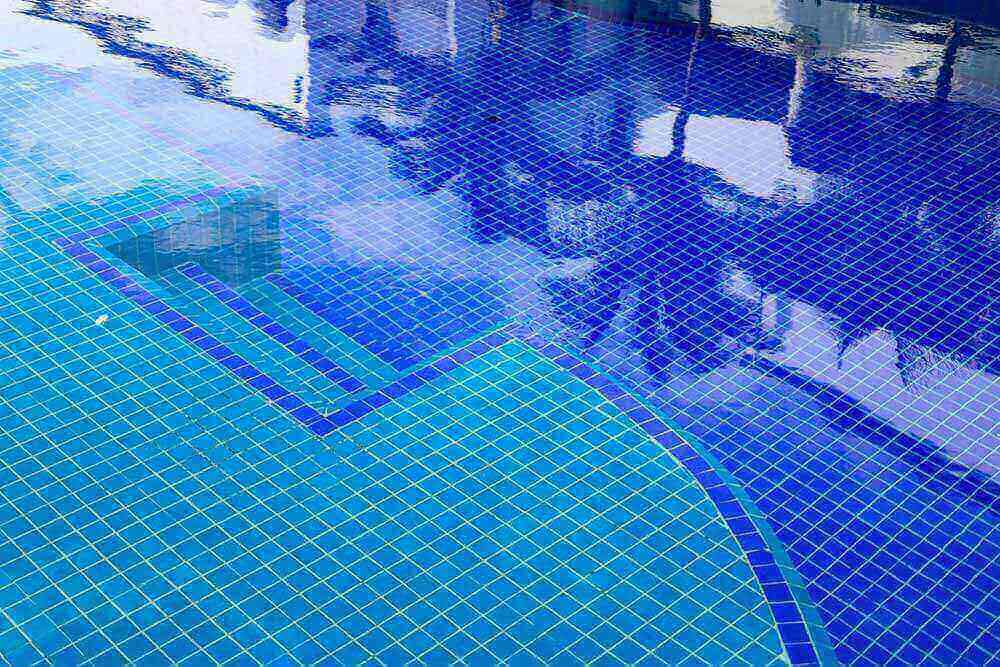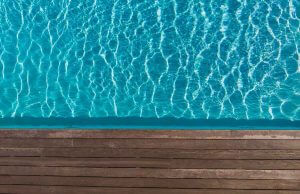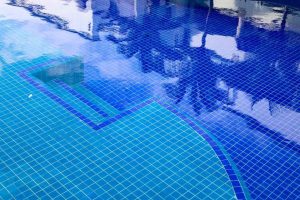Calcium scale buildup can make a fiberglass pool look dull and feel coarse to the touch. A surface that once reflected light evenly can develop a thin, gritty film that resists normal cleaning. These signs are usually calcium silicate, a compound created from lime and diatomaceous earth under heat and pressure.
At Okeanos Pools GTA, we know how firmly calcium silicate can bond to fiberglass, and how it stands up to brushing and basic pool chemicals. The most reliable method is to identify the deposit correctly and rebalance the water chemistry after cleaning. By the end of this article, you’ll know just what to do when that bothersome thin, white gritty layer appears, and how to protect the gelcoat and preserve the pool’s smooth finish.
How to Clean Calcium Buildup From Your Swimming Pool
What Does Calcium Silicate Look Like on a Fiberglass Pool?
Calcium silicate deposits appear as a rough, chalky coating on pool walls that resists standard brushing, but a simple test using a few pool water drops of muriatic acid in pool water can confirm what type of deposit is present. Calcium carbonate deposits will fizz under acid contact, while silicate will remain solid.
Once identified, a fiberglass-safe calcium removal kit is a safe approach that will bring your pool’s chemicals to a normal level without permanently damaging it. You should avoid abrasive tools like pumice stones or rough scrubbers that can permanently scratch a fiberglass pool shell.
The Correct Way to Remove Calcium Buildup Without Surface Damage
Removing calcium silicate from fiberglass requires a controlled and patient process. A specialized calcium dissolving compound should be applied evenly to pool stains and allowed to soften the calcium build up to soften before brushing it gently with a nylon pad.
This works across both salt water pools and traditional chlorinated systems. Harsh chemicals, granular chlorine, or acid washing can erode the blue finish and leave permanent marks. Professional-grade products preserve the gelcoat’s integrity while lifting deposits effectively.
How Balanced Water Chemistry Supports the Removal Process
Once calcium deposits begin to loosen, water chemistry becomes the key to finishing the job. Lowering the pH to around 7.2 and maintaining total alkalinity near 80 ppm creates an ideal environment for dissolving remaining scale and keeping the pool clean. Free chlorine levels must stay within a normal range, since excessive chlorine or sodium bicarbonate can restart the formation of calcium deposits. Saltwater chlorine generators continue to produce chlorine even at reduced settings, so proper monitoring keeps chlorine production stable and controlled.
Proven Methods to Prevent Future Calcium Formation
Prevention is driven by regular testing and steady maintenance. Checking calcium hardness levels, keeping pH balanced, and using a calcium prevention formula that suspends soluble calcium all help stop scale from returning. A clean pool filter and consistent circulation lessen mineral buildup and help to remove calcium carbonate.
A pool cover protects the surface from evaporation, helping maintain calcium levels within range. For pools with high calcium hardness, a reverse osmosis water treatment can correct the imbalance without draining the pool.
Why Professional Service Protects Your Investment
When a thin white layer reappears or the pool surface feels rough again, it signals unbalanced water or damage within the pool interior.
At Okeanos Pools GTA, durable design and expert care define our work. Explore our residential fiberglass pools and assisted pool installations, or contact us to book a professional consultation. Every project we handle is built for longevity, engineered for strength, and maintained with the same precision we bring to every pool across the GTA.





